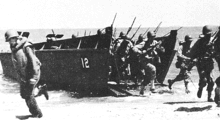Landing Craft, Vehicle, Personnel
The Landing Craft, Vehicle, Personnel ( LCVP ) or Higgins boat was the most popular landing craft in World War II .
Development history
The LCVP was designed and developed by Andrew Jackson Higgins from Louisiana. Andrew Higgins had initially worked in the timber business and moved into boat building after bankrupting his timber haulage company in 1930. The Eureka boat he developed was based on a design for boats that could be used in swampy areas. There were more than 20,000 boats at Higgins Industries and license built.
In the period leading up to World War II, the United States Marine Corps was looking for better ways to land troops on the beach of enemy coasts during amphibious landing operations . The Marine Corps became aware of Higgins. In 1938 the boats were tested by the Navy and Marine Corps. The Eureka boat passed the requirements of both troops and was tested for practicality in a maneuver from 1939. Two machine-gun stands were installed in the bow area as armament. In their first version, the boats had the disadvantage that loading, unloading and manning took place via the side walls of the boat, and the soldiers were exposed to enemy fire. Nevertheless, the boats were procured in large numbers. They were named Landing Craft, Personnel (large) ( LCP (L) ).
After Higgins was shown pictures of Japanese landing craft with a bow ramp from the Second Sino-Japanese War of 1937 in 1941 , it took only a month before a Eureka boat with a bow ramp was available for testing. The boat passed all tests to the satisfaction of those involved. These boats were named Landing Craft, Personnel (Ramped) ( LCP (R) ). The ramp on the boats of this version was too narrow and therefore a bottleneck. This was due to the two machine gun positions next to the ramp, although these were already positioned very close to the ship's side.

The next stage of development was a boat with a ramp the full width of the boat. The soldiers were able to get off the boat quickly via this new ramp and it even allowed a jeep to be taken along . In order to save the steel required for larger ships, the boats were made of plywood and could transport a complete train of 36 men to the coast at a speed of around nine knots . The machine guns of this type were relocated to the rear . This version received the classification Landing Craft, Vehicle, Personnel ( LCVP ) or, in common parlance, Higgins boats .
commitment
LCVP did not operate independently, but were mostly carried on deck by larger landing craft. Depending on the type of ship, their equipment consisted of two to 15 LCVPs. From these ships the soldiers climbed over nets into the boats lying alongside and left them via the bow ramp when attacking the beach.
General Dwight D. Eisenhower said of the Higgins boats, “Andrew Higgins ... is the man who won the war for us. ... If Higgins hadn't designed and built the LCVP, we would never have been able to land on open beaches. ”In the landings in Normandy, as well as in operations in Africa and Italy, the boats were vital.
Technical specifications
- Displacement: 8 ts
- Length: 11.0 m
- Width: 3.3 m
- Draft: stern 0.9 m, bow 0.7 m
- Speed: 9 knots (17 km / h)
- Armament: 2 × 7.62 mm machine guns
- Crew: 3
- Capacity: 36 soldiers or a 2.7 t vehicle
or 3.7 t cargo - Drive: 1 × 225 PS (168 kW) diesel engine or
250 PS (186 kW) gasoline engine from Hall-Scott
LCVP in other navies
The LCVP classification is also used in non-US armed forces for smaller landing craft. Common characteristics are the bow ramp and the load capacity for a vehicle and soldiers up to the pull strength. Modern LCVPs are no longer made of wood, but made of metal or plastic. Some of them are more motorized and reach higher speeds than the Higgins boats. The South African Navy has LCVP with a top speed of 40 knots.
Web links
- Ships of the US Navy, 1940–1945 : LCVP (Engl.)
-
History of US Marine Corps Operations in World War II Volume I
Chapter 3: Development of Landing Craft (Engl.) - USS Rankin (AKA-103): LCVP (Eng.)
- USS LST 494 Higgins Boats (Engl.)
- Second World War: "The man who won the war for us" ( Memento from May 23, 2012 in the Internet Archive ), article by Matthias Oden in the Financial Times Germany , May 22, 2012
Individual evidence
- ^ Marines from all over the world - South Africa; in: Marineforum 3-2009, p. 48


